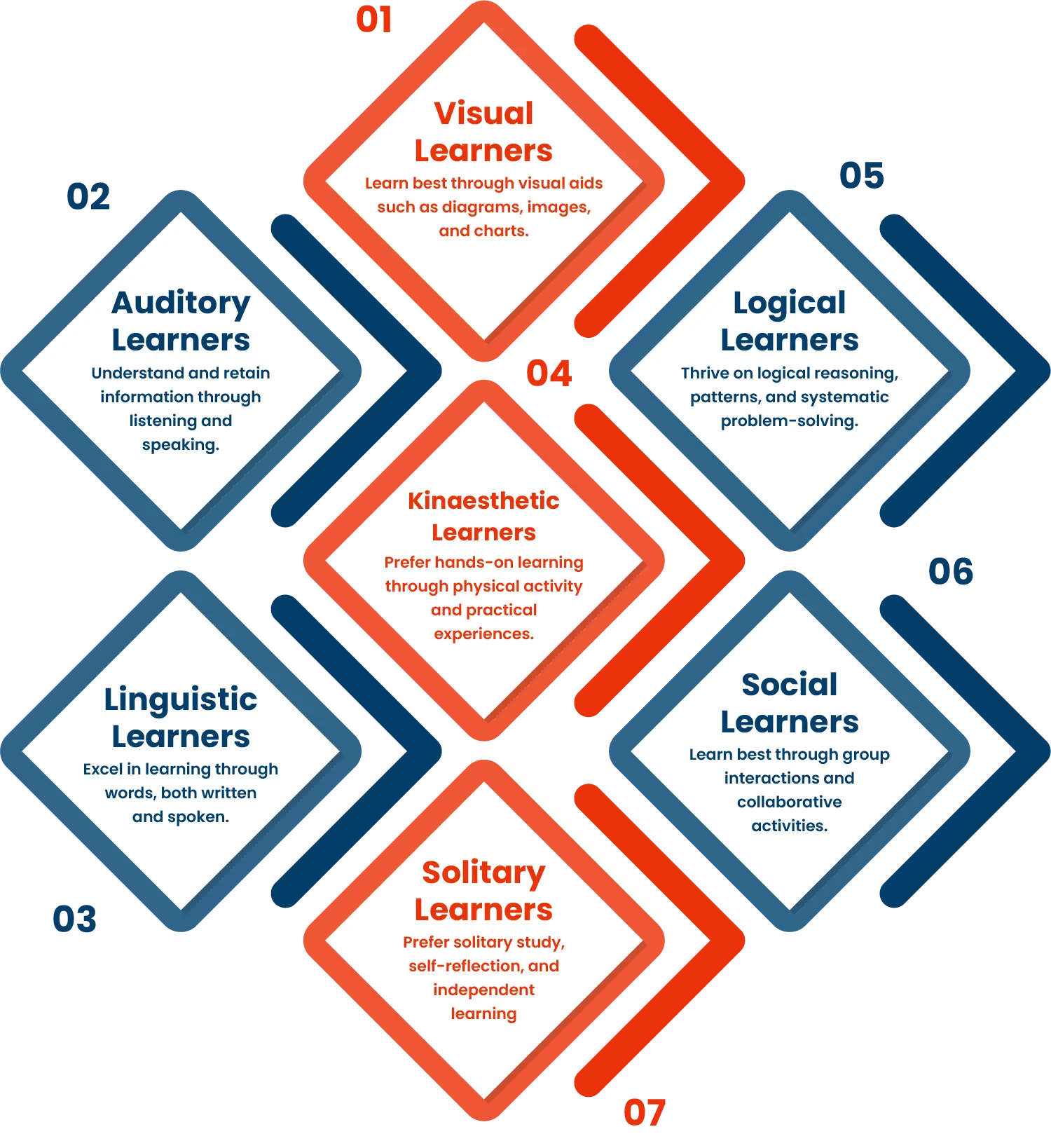Every learner absorbs knowledge in a unique way, and recognising these differences is key to unlocking their full potential in the classroom. An effective teaching style is one that adapts suitable teaching strategies according to the learning styles of different types of learners in the classroom while ensuring better comprehension and retention.
Effective use of technology in teaching starts with understanding its role in the modern education system. In today’s technology-driven world, educators need to equip themselves with digital skills to meet the current and future demands in further education.
Key Takeaways:
- Every learner has different learning preferences, and effective teaching adapts to these preferences to ensure better comprehension and retention.
- Aligning teaching methods with students’ learning styles encourages a more inclusive, engaging, and effective learning environment.
- Educators can identify learners’ styles through observation, feedback, and diagnostic tests, which helps tailor teaching strategies for optimal learning outcomes.
Different types of learners take in information differently, affecting their engagement in the classroom and how effectively they learn and understand things. While no learner is limited to a single style, they often have strong preferences.
Considering these preferences is essential for educators, trainers, and parents. When they align their teaching methods with individual learning styles, it would create a more personalised and inclusive approach in education.
In this blog, we explore the seven most common types of learners: Visual, Auditory, Linguistic, Kinaesthetic, Logical, Social and Solitary learners. We will also discuss how to identify each learner type and provide strategies to support them, helping to create a more effective and supportive learning environment.
7 Common Types of Learners

1. Visual Learners
Visual learners process and retain information better through visualisation, using images, diagrams or spatial understanding. These learners think in pictures and often prefer to learn with written instructions rather than verbal explanations.
These learners are fascinated by visual elements such as charts, graphs and illustrations in a lesson. Their spatial awareness helps them connect ideas based on how information is arranged visually.
Strengths:
Visual learners observe keenly, and little details in their surroundings won’t go unnoticed. They have often photographic or nearly photographic memory, making them good at remembering faces, layouts and visual sequences.
With strong visualisation, they can remember complex topics and lessons easily with the help of diagrams or symbols.
Support strategies:
These learners will be supported by using the following strategies;
- Use diagrams, flowcharts, and mind maps to break down overly complex topics.
- Incorporate visual aids such as infographics, posters, and illustrated slides during instruction.
- Encourage using colour-coded notes or highlighting systems to organise written content.
- Provide visual timelines, graphic organisers, and labelled images for easier comprehension.
- Allow learners to sketch or draw concepts to reinforce understanding.
2. Auditory Learners
Auditory learners absorb information best through listening and speaking. They are susceptible to the sounds. They often think and respond to tone, rhythm, and verbal patterns.
Auditory learners tend to remember information when it is explained verbally; they prefer to learn through lectures, conversations and audio recordings. They talk through ideas and topics to comprehend them better.
Strengths:
Auditory learners usually have strong communication skills as they excel in verbal tasks such as narration, explaining ideas, and having frequent discussions. They remember instructions and conversations with all the details relating them to the sounds.
Sometimes these types of learners have a strong musical sense and can identify rhythms due to their sensitivity. This way, they can learn through songs, rhymes, or mnemonic devices.
Support Strategies:
- Use verbal instructions, classroom discussions, and storytelling to present content.
- Incorporate audio resources such as podcasts, recorded lectures, or voice notes.
- Encourage learners to read aloud.
- Include group work and peer discussions to reinforce key concepts.
- Use rhythm, repetition, and mnemonic devices to help memorise information.
3. Linguistic Learners
Linguistic learners learn through words and language-based activities, whether written or spoken. They love to read, write, listen, and talk, and they have an affinity for languages and words.
Linguistic learners enjoy reading books, essay writing and engaging in debates or discussions. They also love to learn new vocabulary and languages. Most linguistic learners journal and make detailed notes on stuff they want to remember. This habit lets them reinforce their learning.
Strengths:
Linguistic learners excel in writing and reading comprehension. They can express themselves clearly with their words. These learners are good at learning languages.
This type of learner performs exceptionally well on assignments requiring text analysis, building up an argument, or language interpretation. Due to their linguistic skills, they can remember written information effortlessly.
Support Strategies:
- Provide them with written resources like handouts, reading lists, and detailed instructions.
- Assign reading comprehension exercises, essay writing, or creative writing tasks.
- Encourage journaling, reflective activities, or structured note-making.
- Incorporate storytelling, narrations, vocabulary-building tasks, and quizzes in daily work.
- Provide opportunities for learners to research and summarise information in their own words and create presentations, speeches, or essays.
- Introduce them to mnemonic or wordplay with rhymes, acronyms, or word associations..
4. Kinaesthetic Learners
Kinaesthetic learners are those individuals who prefer to learn through practical means. They can better understand the concept when they are engaged physically in the learning process. The learning process can include practical work such as building models for processes, doing experiments or using gestures.
Kinaesthetic learners learn while actively engaging with the learning; they struggle with passive learning. Listening to lectures or reading long texts without interaction does not hold their attention or support their understanding. For these learners, movement and physical experience are not distractions but essential components of how they process and retain information.
Strengths:
Kinaesthetic learners exhibit strong motor memory due to excelling in practical tasks. They learn through hands-on learning rather than taking a passive role of observation. Their experimental learning style goes a long way, particularly in subjects that require physical demonstration, experimentation, or manual skills.
Support Strategies:
- Incorporate practical exercises like role-playing, lab work, and craft projects.
- Design activities that require activity, such as interactive games or simulations.
- Use tools like manipulatives, physical props, or task-based challenges.
- Make sure to include little breaks during the lecture, providing opportunities to move during lessons.
- Encourage project-based learning and application of concepts in a real-world setting.
5. Logical (Mathematical) Learners
Logical learners are drawn to the learning process that consists of a system that requires thinking or has a logical backup. They are inherently fascinated by how things operate and like to look for principles behind ideas. These learners are curious and employ a cause-and-effect pattern to comprehend the information.
Logical learners use the analytical approach in their learning process and often question and challenge the ideas to conclude with logical reasoning.
Strengths:
Logical learners are critical thinkers and have strong problem-solving skills. They do well in lessons that require thinking, data interpretation and analysis. Generally speaking, logical learners excel in identifying patterns, comprehending intricate systems, and decomposing them into smaller, more manageable components. Their systematic approach makes it easier for them to understand scientific reasoning, coding, and mathematical ideas.
Support Strategies:
- Include problem-solving activities, exercises like puzzles or strategy games, in the learning process.
- Use data interpretation tasks and analytical exercises in different lessons.
- Promote the sequencing and comparison of patterns in the data and form conceptual links.
- Use charts, graphs, and logical frameworks to illustrate ideas.
6. Social (Interpersonal) Learners
Social learners prefer a group environment where they can interact, engage and collaborate. They better assimilate information through having group conversations and constructive criticism in a shared learning environment.
Social learners have open conversations in a group setting while seeking answers to their confusions and work as a team.
Strengths:
Social learners have strong communication skills and are emotionally intelligent due to their continuous group interaction. These learners also exhibit strong collaboration skills, making them an asset in group projects. They are sensitive and cooperative, understand social cues, and listen to their peers’ perspectives responsibly.
Support Strategies:
- Make sure to include more group projects, assignments, and provide more opportunities for peer collaborations.
- To encourage engagement, lead role-plays, debates, and discussions in the classrooms involving all the learners.
- Create an environment in the classroom that values communication and teamwork without hesitation.
- Use peer review or partner activities to encourage feedback and shared learning.
7. Solitary (Intrapersonal) Learners
Solitary or intrapersonal learners want to learn in an environment that supports self-study. These learners prefer an environment that encourages introspection. Moreover, solitary learners are self-motivated, set their own objectives and evaluate their own progress.
These learners prefer a calm environment where they can focus on their learning without external interruptions.
Strengths:
Intrapersonal learners are self-aware and do reflect on their learning. They also display a great sense of decision-making. They are ideal for long-term undertakings and independent study because of their capacity for self-control and concentration. These learners are focused, self-disciplined and have a strong sense of purpose.
Support Strategies:
- Assign these learners tasks that require independent learning, such as research projects or reflective activities.
- Provide them with a learning module that is personalised to their learning pace.
- Create quiet, distraction-free rooms for such learners.
- Engage them in activities where they set their goal, and assist them in this process.
- Provide them constructive feedback personalised to their learning style that encourages a growth mindset
Want to support diverse learners more effectively in further education?
If you’re passionate about creating inclusive, learner-centered classrooms. Advance your skills with a Diploma in Teaching.

How to Identify Different Types of Learners
Recognising individual learning styles of the learners in a classroom is essential for tutors to modify their teaching methods to suit each learner’s needs. By learning preferences, teachers, trainers, and parents can use several practical methods to understand better how a learner learns best.
Observe Behaviour and Engagement
Teachers can observe closely and note how learners interact with the different activities provided. Some learners are going to be more excitedly engaged in practical work, crafting. Some will perform exceptionally in group projects. Tutors and parents must take notes of what captures their focus and at what point they feel distracted. This observation of their engagement pattern will give away their preferred learning style.
Listen to Learner Feedback
Provide learners a safe space where they can express themselves. Oftentimes, learners express their preferred learning method through casual interactions. As a teacher, you must take students’ remarks into account and modify the teaching methods according to the learners’ feedback. You can also ask thoughtful questions to identify the various patterns in learners.
Use Simple Diagnostic Tests
Provide learners with diagnostic tests such as learning style assessment, questionnaires and quizzes that determine prevailing learning preferences. Through these methods using targeted questions, learners can categorise easily into the groups of their preferred learning style. There is always an uncertainty in the use of these methods, but it would familiarise you with the patterns in learning behaviour.
Reflect on Performance Patterns
The strengths of learners and the challenges that learners face hint at their preferred learning style. Learners who are performing well in tasks that involve critical thinking and problem-solving skills, but lack in essay writing. Moreover, reviewing the previous assignments, diagnostic tests, and engagement level tells which teaching approach results in better outcomes. This allows educators to personalise their teaching strategies to support the individual growth of learners.
Conclusion
Understanding that learners require different learning methods to understand similar information. There is not a single learner who can adjust to a single learning style, making it essential to learn about their preferences. By identifying these preferences, educators, trainers, and parents can create more effective, inclusive, and supportive environments that cater to the diverse needs of all learners. Supporting different types of learners not only improves comprehension and retention but also boosts confidence, independence, and a genuine love for learning.





